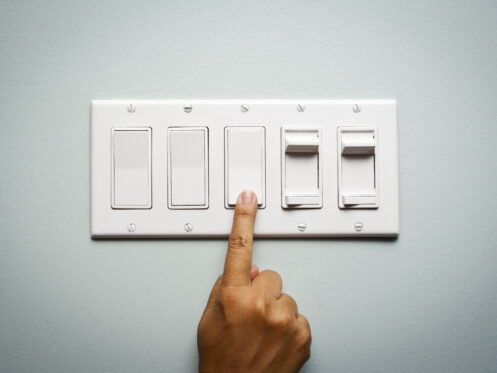Flickering lights can feel like a small annoyance or a freaky coincidence. It’s easy to ignore a quick flicker here or there, but when it keeps happening, you can’t help but wonder what’s behind it. Whether it’s a loose bulb, too many devices on one circuit, or something more serious, identifying the issue now can prevent bigger problems later.
Loose Bulbs and Fixtures
A loose bulb is one of the most common reasons for flickering lights. If it’s not screwed in all the way, it won’t connect properly with the socket. That shaky connection makes the light flicker when you turn it on or accidentally bump something nearby. Usually, tightening the bulb fixes the problem. You might also notice flickering if the bulb’s base doesn’t fit the socket well. Cheap or mismatched bulbs are more likely to cause this problem, especially if they’re in fixtures designed for a specific type of bulb.
Fixtures themselves can also be part of the problem. Over time, wiring connections in ceiling lights, chandeliers, or lamps can loosen. Movement, age, or even a less-than-perfect installation can leave you with flickering lights. If you wiggle the fixture and the flicker stops or gets worse, you’ve probably found your culprit. It’s not just about the light itself. The wires behind the fixture may have loose connections, causing an uneven flow of electricity.
Make sure you use the correct type of bulb for your light fixture. Older fixtures may not work smoothly with newer LED bulbs. Using the wrong combination can cause flickering. Before worrying about bigger issues, try switching to a compatible bulb.
Power Supply Problems
If your lights are flickering all over the house, it’s probably more than just a loose bulb. Power supply issues can cause more widespread flickering, especially if you live in an older home or your area has a history of power surges. Even if it’s not happening constantly, occasional dimming or flickering can signal a supply problem.
Voltage changes can also cause flickering. Your home’s electrical system works at a set voltage. When the voltage increases or decreases, your lights can flicker.
The same problem can happen if your home’s overall electrical load has grown over the years. Maybe you’ve added new appliances or renovated parts of the house without updating the wiring. The more devices you plug in, the harder your electrical system has to work. If it can’t keep up, you’ll see those effects in your lights. Widespread flickering deserves attention, especially if it appears to follow a pattern or occurs in conjunction with other symptoms, such as tripped breakers or warm outlets.
An upgraded electrical panel may be the best solution. This can increase the overall amperage available. Many newer panels can reduce energy use. You can also opt for whole-home surge protection, which we typically install at the panel.
Faulty Wiring Concerns
Old or damaged wiring doesn’t always show obvious signs. Flickering lights can be an early indication that something is wrong. If you’ve checked for loose bulbs or power issues, it might be time to take a closer look at the wiring. Electrical wires can deteriorate, especially in older homes.
Poor connections between wires create a weak spot where electricity can’t flow evenly. That inconsistency manifests as flickering, dimming, or brief power losses. Wires can also break down due to pests, corrosion, or physical damage. If you’ve had work done around your house that involved drilling, nailing, or cutting near electrical lines, you could have damaged wiring without realizing it.
Overloaded Circuits
You might not think twice about plugging in another device, but overloaded circuits can cause all kinds of trouble. Each circuit in your house can only handle so much power. When you exceed that limit, the system tries to compensate. Sometimes, that means your lights flicker or dim when you turn on another device.
Older homes often encounter this problem because their electrical systems weren’t designed for modern power needs. Adding new gadgets, appliances, or entertainment setups increases your overall load. Even if your lights flicker only occasionally, that repeated stress can cause wear on your system. Over time, the problem only gets worse.
If your lights flicker more when you’re using a bunch of big appliances at once, your circuits might be overloaded. Try plugging things into different outlets to see if it helps. If the problem persists, you may need to upgrade. Adding new outlets and circuits can help when your power needs have changed. Sometimes, you may also need to upgrade the electrical panel to accommodate more circuits.
Problems with Dimmer Switches
If your flickering lights happen mostly in rooms with dimmer switches, that’s worth looking into. Dimmer switches control the amount of electricity flowing to the bulbs. When those switches aren’t compatible with the bulbs you’re using, you’ll notice inconsistent performance. This happens most often with LED bulbs.
LEDs work differently from incandescent bulbs. They use less power and have their own way of converting electricity into light. Not all dimmers work well with LEDs, especially older models designed for incandescent bulbs. Even if the switch technically works, it might not deliver a steady current.
Sometimes, it’s a simple fix. Switching to compatible bulbs or replacing an outdated dimmer switch can make a difference. If you’ve tried other fixes and the lights still flicker, something else might be messing with the power flow. Dimmer switches only work with what they’re connected to, so an issue somewhere else in the circuit could be the real problem.
Problems Related to Utility Service
Even if everything inside your house checks out, flickering lights can still happen if the problem starts outside. Your power company delivers electricity to your home through a network of lines and transformers. Damage or maintenance issues along that path can cause voltage fluctuations.
Bad weather, tree branches, or construction work can interrupt power flow. Sometimes, the issue only lasts a few minutes. However, if it continues to happen, your lights will continue to flicker. Checking with your power company helps you figure out if the problem is beyond your control.
Sometimes, utility companies perform maintenance or switch loads between circuits to balance demand. If you notice flickering during peak usage times, such as early evening when everyone is running appliances, that could indicate a strain on the local grid. Issues where the power lines connect to your home’s wiring can also cause flickering. If the problem’s there, it’s best to call a professional. Attempting to fix it yourself can be hazardous and may exacerbate the issue.
Fix Your Flickering Lights Today
At Pipe Works Services in Chatham, NJ, we’ve helped countless homeowners solve their flickering light mysteries and get their systems working the way they should. As a full service electrical company, we can help with panel replacements, indoor and outdoor lighting, electrical upgrades, surge protection and more. For dependable help and expert guidance, schedule a visit from Pipe Works Services today.





